Specifications
 Haynes
and the factory turbo Workshop Manual state the turbo has two compression
rings. Maybe some did. Mine, with Mahle pistons, had the usual 2 compression 1 oil.
Haynes also lists turbo compression at 7.5:1 across the board. The factory Workshop
Manual specifies 8.0:1 from the 80 model.
Haynes
and the factory turbo Workshop Manual state the turbo has two compression
rings. Maybe some did. Mine, with Mahle pistons, had the usual 2 compression 1 oil.
Haynes also lists turbo compression at 7.5:1 across the board. The factory Workshop
Manual specifies 8.0:1 from the 80 model.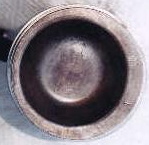
924 and 931 pistons are cast, (except the GT piston which is forged.) The 8.5:1
piston used used on the 177HP engine has the same size, so it is possible to fit a GT
piston. The cast piston, PN 931 103 048 01, is manufactured by Mahle and the weight is
530 gram. The forged one, PN 931 103 042 01, is made by Kolbenschmidt and the weight is
471 gram.
EBS sells all sorts
of 924 pistons including, OEM, GT type
Kolbenschmidt 8.5:1 forged, 471 gm, $595.00 w/ rings, wrist pins and circlips, Mahle
cast, std 7.5:1, $395.00 w/ rings, wrist pins and circlips, and finally, J.E. in custom
CR's $625.00 W/ rings, wrist pins and circlips. If you buy from the manufacturer you pay
more money. In this case it is more economical to go through a large retailer.
All engines use the same forged crankshaft. (924 & 931)
The 924S got an additional 10 hp for 1988.
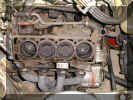 Seems
a good place to put a picture of a naked block. Note the non-stock headers and the short
oil filter.
Seems
a good place to put a picture of a naked block. Note the non-stock headers and the short
oil filter.
More more pictures of naked blocks, and actually a sequential series of a rebuild of
the 924NA motor, check out PUB Racing's
Engine Rebuild Page.
General Description and pictures of Australian and Euro Spec cars at Darrins
2 - Engine Mods: More Power?
A tuning trick for the 924 is to fit a 931cylinder head gasket. It is thinner and
will give around half a point higher compression.
The part number is 931 104 337 03 - Ole Kammersgaard
The most frequently asked question is, "How do I get more power ...".
Uusually implied is the unstated thought, "What is the single bolt-on piece which
is effective or cost effective?" With this engine the simple and short answer is
Nothing! There. That was easy and saved a bunch of money. If you look in the references
section there are brief reviews of several articles in several different sources all
demonstrating that the engine does not respond particularly well to bolt-ons.
Additionally, Eric Lynch has compiled a very interesting library of 924
Power Tricks. This includes scans of many older magazine articles from various
attempts to hot-rod the 924. Jon McCullough (AKA AppleBit) has also compiled his
Tricks'n'Mods on his website: http://204.72.34.61/porsche/p924.html.
The following is from a message to the Porsche List by Jim Pasha. Jim knows these cars
better than anyone and explains it concisely.
924 Engine mods, From: Jim Pasha, Mon, 5 Oct 1998,
The mods that make the most difference in a 924 NA engine are displacement and
ignition curve for US cars. Most other mods just add to reliability, that is, port clean
up, multi-angle valve grind, Headers ,intake mods, etc.
The 933, the DP road race 924, used the 931 head as it has a slight combustion
chamber in the head , but requires some very strange looking pistons to get any sort of
compression. The stock intake and exhoust from the NA engine bolt right on, though a
4-into-2-into1 collector header works best. Join #1 and #4 together with #2 and #3
then those two into a single collector. I can give the lengths that work to anyone
interested. Done correectly there is an 8HP gain.
If you are rebuilding, check the camshaft lobes for lift and visible damage as a
slightly worn lobe will cause a bad idle. One thing worth considering, Ottinger made a
2.3 Liter kit for the 924 many years ago. This would bring a Euro engine to 145Hp.
Compression is 9.5:1 so HC should not be adversely affected and it will run on most US
fuel as well. (ed note: Jim Pasha mentions a 2.3L kit which may or may
not still be available; PAECO in Birmingham AL makes a 2.2 stroker kit for the 924.
Furthermore, there are reported to have been one or two 924's with an Audi 5-cylinder
installed, at 2.2 liters...)
Balancing makes a big difference in smoothness to the NA engine. Have the cam
bearings checked for wear and refinished if necessary. Worn cam bearings, which are
actually the head and cap can cause oil pressure readings to fall off. Always install a
new cam oiling tube and connector. The connectors are plastic and will leak or break,
keepping oil from reaching the the cam lobes and bleeding off oil pressure. I generally
use a new oil pump, though they are expensive. The pump gears will wear on the plates,
causing pressure bleed off. A new pressure bypass valve should also be considered.
For the injection, If you have a rough idle, check the o-ring seals for being hard
and leaking air past. Squirt a littl water around each injector and see if the engine
runs rough. If it does, then it's sucking air. The injector sits in a phenolic housing
that is both an insulator and mount. These are threaded and can leak around the threads.
Any air leak will cause a rough idle.
The injection is pretty fool-proof. Oil residue on hte air sensor plate causes idle
flutter and roughness. Simply remove the boot and wipe both the top and bottom of the
plate to get the crud off. You will notice a difference on an engine that was running
rough unless it has other damage.
The biggest cause of rough running or idle is a worn camshaft. Any scratch on the cam
follower will eat against the cam and lower the lift of the particular lobe. This is an
endemic problem with the engine type, both in the Porsche application and the Audi/VW
application.
A broken right side engine mount spring will also cause some vibration at idle.
Battery acid is flushed from the battery compartment right over the mount and will
corrode the spring. Replacement is the cure. I have used left side mounts in that
location, but be forwarned that heat from the exhaust will affect the lift of that
mount.
Studs:
Read the Porsche technical spec for any model that uses head studs, the 944
being one of the best. Use a light oil, as Dave has pointed out, when you
torque the nuts onto a head stud.
Bolts may be reused in any stock application providing the threads are in
good condition and the engagement point for the socket, inner or outer style
is not damaged. The 924 and 931 studs are not really stressed that hard in a
normal application. If you want to build a hand grenade motor with 20psi of
boost, then worry about studs.
The primary advantage of studs is the ability to use a finer ptich thread to
make for a more evenly distributed torque. You actually get s more accurate
torque with the finer threads that you would wioth the coarser threads
usually employed with bolts.
Finer threads also reduce the amount of twist, the use of oil stress relieves
the torque and twist on the stud.
Studs do work better when bottomed, however, the more thread engagement you
have, the beter the pull is. Just because a stud is bottomed, it may not be
any better than one that is not. For heads, engagement of twice the diameter
of the stud is usually adequate. In all applications, the block threads must
be chased with a bottom tap to ensure there are no galled threads and that
all the crud is out of the bore. This especially true for the 944 engines.
If the total compression (dynamic) will be over 10.5:1, use studs. Some
static calculations assume a complete closure of the valve at all times,
however, in the real world, ramp angles on the cam lobes reduce the total
compression by limiting the amount of time the valve is closed and therefore
lowering the dynamic compression. Many people that have 11.5:pistons don't
realize that the dynamic compression is much lower. A turbo reaces peaks in
compression only under boost. And not usually for long periods of time, even
on the sutobahn. A static compression (high) is around all the time and
causes much more stress. At the low rate of boost in the stock 931, studs
only are stressed thermally in most cases, and with the knowledge gained in
the last 20 years, most of those problems can be minimized or avoided.
- Jim Pasha
WARNING: Dont Cut Up Your AIR BOX for more HP
by Steen Andersen, 76 924, steand@post8.tele.dk
I keep reading that cutting up your air intake box, so only a small rim is left for
holding the air filter, will give your more horse power a cheap way. SO! I did it, and it
makes a wonderful sound, but it decided to put it to a test. And the main result is that
it doesn't give any gains in HP. Therefore my advice is, Don't Cut Up Your AIR BOX for
more HP, You will only gain more noise, and a more dirty air filter. The complete test is
on my website under http://home13.inet.tele.dk/steand/924/Dyno.htm
I have made a test off the effect off cutting up the air box, among some dyno runs i
made. The result is on my homepage on the address. http://home13.inet.tele.dk/steand/924
The sub page DYNO contains the tests.
My conclusion: It only have an effect on the sound.
The right engine mount is a coil spring inside rubber. The engine hangs on both. The
springs are hidden inside rubber when installed. The way the mount is constucted
it may not be obvious that the spring is broken. The rubber will continue to support the
engine, but without correct dampening. The picture is of a right side mount from a 1982
924. The car had been through several tech inspections and the broken mount was not
found until removed. Difficult to see, but the spring is broken inside the rubber. This
is caused/accelerated by corrosion from the drain out of the battery tray. When this
mount was replaced the engine was suspended only slightly higher than before, but
was smoother. In other words, you could not tell it was broken until it was removed.
If you have an old 924 and the right mount looks origninal: it probably should be
replaced.
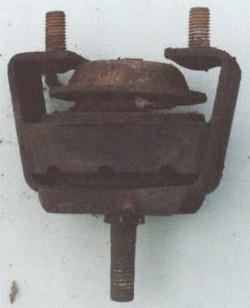

You racers might be interested in this received from the UK:
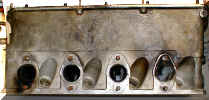 924
exhaust side with spark plugs
924
exhaust side with spark plugs
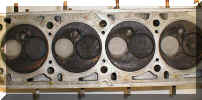
See how flat the head is on the combustion side.
 Blow
this up to get a good look at the flat chamber.
Blow
this up to get a good look at the flat chamber.
German head gasket, the OEM ones (Victor Reinz is the OEM manufacturer),
are the only ones to use. The American ones are a waste of money and incorrectly made
for the 924 engine. They are intended for the AMC cars that used a variation of the
engine in Gremlins and Hornets in the late 1970s.
4.1 Porting and Polishing - How To
(1) screw studs into the intake manifold or head (if removed);
(2) align gasket correctly over port openings;
(3) slip gasket over studs and tighten down with nuts;
(4) use a fine felt-tipped marker to trace an outline of the inside of the
gasket onto port;
(5) remove nuts and gasket and grind away up to and including the marker
line;
(6) repeat steps 2-5 to verify port fully opened.
According to what I read you only need to go about 1-1.5" into the ports.
Make sure you blend the end of the port area you grinded smoothly into the
untouched port area.
Places that need work on the head are the casting marks that run along the
inside of the intake ports of the head (use you finger to feel around on the
inside of the port), the area next to the valve guides (sharp corners), and
the ridge where the valve seat and head come together.
All it takes is a little common sense and a lot of patience
-Peter A. Holiat
Valves
Lots of opinions. One of the big mods is the 'big valve' head. But
reports are that mod tends to crack between the valve seats because there is too little
material left. There is some question also as to whether the larger valves alone make
any difference or are just along for the ride and other changes made do the real work.
When replacing the valves you can find standard replacements (in stainless no less)
cheaper and at least as good as OEM. So far I know: turbo exhaust - TRW 3085/1
Camshaft
Schrick in Germany had a few good grinds 15 years ago; but I do not know
who is dealing for them here in the US. JPasha
Webcam is another cam grinder, favored by a lot of PCA Club Racers in
the US
David Ewing, "I was chatting with Mr. Dimitri Elgin at Elgin Cams
about the 931 camshaft profile. He related the camshaft used in the 924 and 931
are
identical. Porsche engineering relied on the boost to
increase the charge volume, no provisions to optimize the breathing of the head with the
turbo.
The part number is located on the casting near the distributor gear."
Intake Duration@.050" Lift Exhaust
Duration@.050" Lift
222
.470"
222 .465"
5 - Throttle Body Upgrade
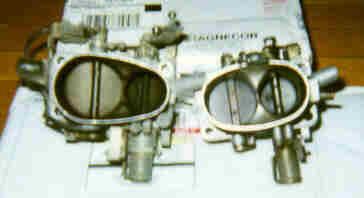
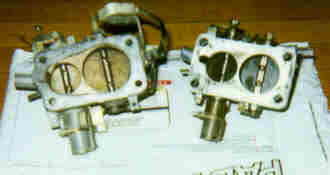
The throttle body (TB) upgrade is a well-known modification, and very attractive due
to it's simplicity. Based on experience with various TB options available for the 924,
the serious performance results are minimal; however, the upgrade can be performed very
inexpensively, and performance often feels subjectively better to the driver. The swap
may be even more useful on turbo cars, since they are more sensitive to intake
restrictions than NA cars, but it is generally believed that the TB is not the main
restriction in the turbo's intake system, perhaps unlike more recent import hot-rods.
Neuspeed and Weber both make (or have made) big-bore TB's that fit the 924, though
availibility of these may be a little tricky. Market price seems to be around $200 USD
new. Somewhat less expensively, the TB from a 5-cyl Audi or, though less desirable than
the Audi, a 16V VW, can be used with similar results and ease of installation, with
substantially reduced financial impact, since these are stock units readily available
from a junkyard or wrecker's.
The stock 924 TB has bore sizes (diameters) of 36mm/46mm primary/secondary - as the
throttle is opened more and more (loud pedal pressed down), first the primary, then the
secondary opens up, providing a non-linear throttle response and better driveability at
low throttle openings. The Audi and VW units retain this primary/secondary arrangement;
more recent aftermarket TB's also have this feature, though some early models may
feature only one port.
There are a couple of different Audi TB's available; the best way to identify them is
to bring along a set of calipers to take measurements at the yard. Some TB's have
primary bores the same size as the stock 924 TB, with only a larger secondary bore;
others (such as some 5000 and 5000S) have a 39mm/53mm primary secondary. Regardless of
size, they can typically be found in US junkyards for around $25USD.
To obtain the most from the modification, port the intake manifold to match the
enlarged throttle body - the old gasket can be used as a guide for this. The bolt
pattern on the TB is the same, but the throttle cam from the 924 TB will need to be
swapped onto the donor TB - the nut on the top of the throttle shaft is removed, and the
swap is easily made. Later 924's will also need to ensure that the throttle switches are
properly aligned; the dual switch can be positioned with longer bolts, with nuts; the
third reed switch on '81 onward cars may need to have a mounting point drilled and
tapped. YMMV, depending on what car you use as a donor. Don't forget to make sure idle
speed and mixture are adjusted after installation.
What follows are a couple of driver's impressions of the changes:
Driveability is slightly improved over stock, retaining the nice primary/secondary
function, but spooling up a little faster. It doesn't feel that, in spite of
part-throttle gains, that the bottom line power has been improved, but it'll take
acceleration runs or dyno time to show that. - Vaughan Scott
Power gains are noticeable in the higher rpm’s. The lower rpm’s are unchanged.
This modification works well on both stock and modified cars, turbo or non-turbo. -
Daniel Varholy
Thanks to Dan Varholy for input on this section!
10 Engine lubrication - general
description
The Pressure Bypass Valve (which is not discussed in the Haynes manual)
is easily accessed via a large (17mm) plug in the front of the oil pump, at the front of
the engine. Unscrewing this plug will allow the valve piston and valve spring to be
removed and inspected - but it is usually worth just replacing these two components
outright, in addition to the copper crush washer on the plug, as they can usually be had
from the dealer for less than USD$10. Don't get caught replacing the plug itself,
however; it is many times more expensive (and does not typically need to be replaced
anyway).
The standard filter is Fram PH2870A or Pennzoil PZ12 or equivalent. Cars
with headers installed may have interference with the filter. Use a shorter
filter: Fram PH3614 or Pennzoil PZ21 or equivalent. These are about 1 1/2 inches
shorter. The only spec I can determine which is different is the bypass pressure. The
shorter filters bypass at around 10 psi rather than 30psi. A review of the applications
for both size filters would indicate that this is not an operational concern.
It says this because....
 Haynes
and the factory turbo Workshop Manual state the turbo has two compression
rings. Maybe some did. Mine, with Mahle pistons, had the usual 2 compression 1 oil.
Haynes also lists turbo compression at 7.5:1 across the board. The factory Workshop
Manual specifies 8.0:1 from the 80 model.
Haynes
and the factory turbo Workshop Manual state the turbo has two compression
rings. Maybe some did. Mine, with Mahle pistons, had the usual 2 compression 1 oil.
Haynes also lists turbo compression at 7.5:1 across the board. The factory Workshop
Manual specifies 8.0:1 from the 80 model.






